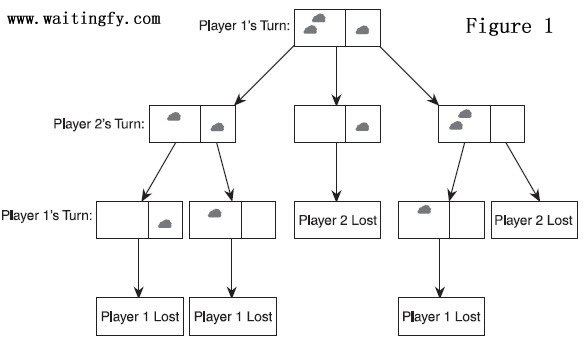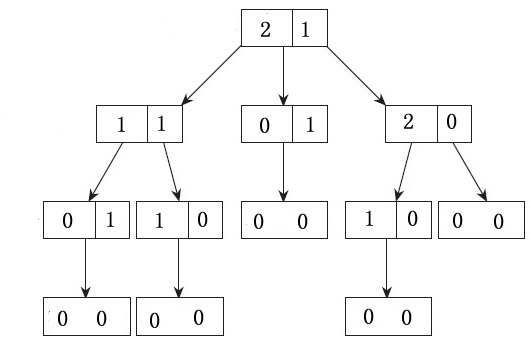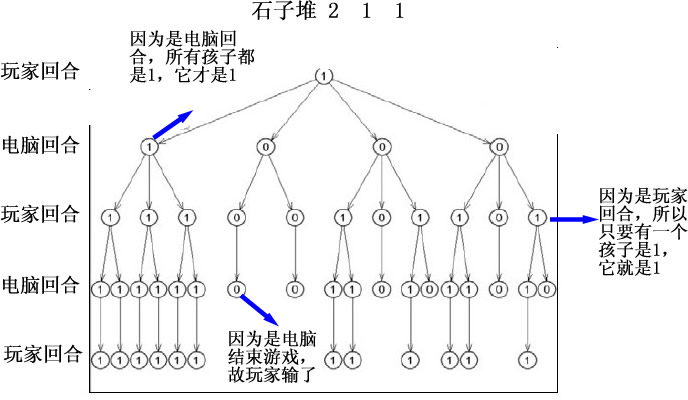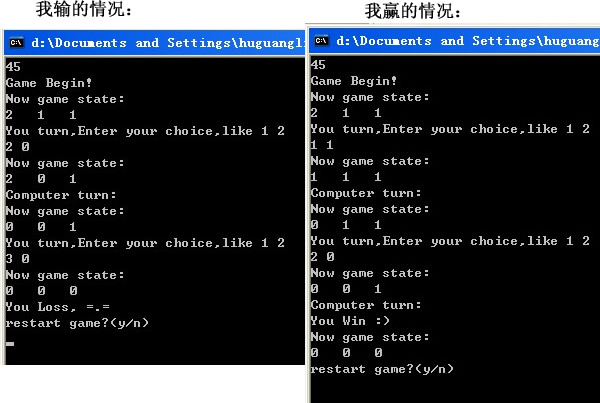Contents
1.游戏图文说明

这个游戏是这样玩的:
开始有两堆石子,第一堆有2个,第二堆有1个,开始是玩家1开始取石子,然后是玩家2取石子,规则是只能取某一堆的至少一颗石子,两人轮流取石子,直到有人取完石子,谁就输了。
上图列出了游戏的所有可能:
假设玩家1取了第一堆中的一颗石子,那么在接下来的回合,玩家2无论取第一堆或者第二堆石子中的一颗,那么玩家1都将会输掉这个比赛。玩家1正确的做法就是取走第一堆的两颗石子,这样就赢了。当然如果玩家1取走第二堆中的石子,除非玩家2脑残地取走了第一堆中的2颗石子,玩家1将会输掉这个比赛。
先好好理解下上面所说的,看起来很简单,我们这次的目的是要创建一个电脑对手,它必须知道所有的游戏可能,它必须足够聪明,让玩家头痛。
2.用程序模拟比赛所有可能
2.1创建一个树的数据结构来存储所有结果

把上面实体的所有比赛过程可以转换成一个树的数据结构。我们需要存储所有的可能。当我们像上面的情况2,1时,有11种情况,然而如果是有4堆石子,它们数量分别是4,2,2,2的情况,总共有228291种情况,计算时间要12秒!真令人吃惊。可能是我写的算法太垃圾。
首先我们创建一个Rocks的类表示每一堆。有两个属性,一个是堆的索引,表示第几堆,另一个表示堆里石子的数量。
class Rocks{
public:
friend bool operator == (const Rocks& p1,const Rocks& p2);
Rocks(const int& Index,const int& Count){
m_index = Index;
m_count = Count;
}
int GetIndex() const{
return m_index;
}
void SetIndex(const int& Index){
m_index = Index;
}
int GetCount()const{
return m_count;
}
void SetCount(const int& Count){
m_count = Count;
}
private:
int m_index,m_count;
};
bool operator == (const Rocks& p1,const Rocks& p2){
return (p1.GetCount() == p2.GetCount() && p1.GetIndex() == p2.GetIndex());
}然后建立一个Node的类,它就是图中树的每个节点。它有多个孩子,有父节点。 有每一堆石子的状态。
//一个node就是一种游戏状态,一个树的节点
class Node{
friend Tree;
public:
Node(const vector<Rocks>& Rocks){
m_rocks = Rocks;
parent = 0;
m_win = -1;
}
vector<Rocks> GetRocks()const{
return m_rocks;
}
int GetHeight(){
int height = 0;
Node *currentNode = this;
while(currentNode->parent != NULL){
++height;
currentNode = currentNode->parent;
}
return height;
}
int GetWin()const{
return m_win;
}
void SetWin(const int& Win){
m_win = Win;
}
vector<Node*> GetChildren(){
return children;
}
private:
vector<Rocks> m_rocks; //每一堆石子的数量
Node* parent; //它有父节点
vector<Node*> children; //它有多个孩子节点
int m_win; //对玩家来说是否是一个赢的状态
};接下来建立Tree类。
class Tree{
public:
Tree(){root = 0;}
~Tree();
Tree(const vector<Rocks>& p); //构造函数,参数是初始石子堆
void BuildMinimaxTree(Node* node); //递归方式创建树
void BuildMinimaxTree(); //非递归方式创建树
Node* GetCurrentNode(); //得到当前所在节点,即游戏玩到哪一步了
void SetCurrentNode(Node* node); //设置当前节点
bool ChangeCurrentNode(const Rocks& p); //更改节点因为玩家或者电脑做出选择了
void ComputerChooseNode(); //电脑做出选择
void Minimax(Node* node); //对树进行统计,看下每个节点对玩家是否有利
int GetCountChoice(){ //得到所有Node的数量
return countChoice;
}
Node* GetRoot()const{ //得到根节点
return root;
}
private:
Node* root; //根节点
Node* current; //当前节点
int countChoice; //总的Node的数量,只是用来看下树总共有几个孩子
};
2.2 第一个难点,如何创建树?
类写的差不多,到了第一个难点,如何创建一个树?一般创建用递归方式,根节点每堆石子少一个石子就是一个新的结果,它们就是根节点的孩子节点,在对孩子节点也同样处理,直到没有节点可处理,树就出来了。
//use recursion
void Tree::BuildMinimaxTree(Node* node){
if(node){
vector<Rocks> p = node->m_rocks;
//对所有堆进行遍历,每堆减少一个石子即为一个新的结果
for(vector<Rocks>::iterator itr = p.begin();itr != p.end(); ++itr){
int saveCount, count;
saveCount = count = itr->GetCount();
while(count > 0){//至少还有一个石子
itr->SetCount(--count);//每次少一个石子
Node* newNode = new Node(p);//got new child
++countChoice;//只是用来计数
newNode->parent = node;
node->children.push_back(newNode);
BuildMinimaxTree(newNode);//build it's child as a tree
}
itr->SetCount(saveCount);
}
}
}
tree.BuildMinimaxTree(tree.GetRoot());
还有一种方式是用双端队列deque来处理,弄过寻路算法的童鞋就知道了。先把根节点加入队列,把它孩子都加入到队列尾部,然后剔除头部,再对刚刚加入的第一个孩子进行这样处理,处理完,剔除。这样一直做下去直到队列为空,树就出来了。
理论上这种没有使用递归的方式会快点的,但在这程序里好像并不明显。
//use deque
void Tree::BuildMinimaxTree(){
deque<Node*> allNode;
allNode.push_back(root);//先加入根节点
while(allNode.size() > 0){
Node* currentNode = allNode.front();//对头部的节点进行处理,把他的孩子都加入到队列的尾部,再剔除头部
vector<Rocks> p = currentNode->GetRocks();
for(vector<Rocks>::iterator itr = p.begin(); itr != p.end(); ++itr){
int saveCount, count;
saveCount = count = itr->GetCount();
while(count > 0){
itr->SetCount(--count);
Node *newNode = new Node(p);
++countChoice;//只是用来计数
newNode->parent = currentNode;
currentNode->children.push_back(newNode);
allNode.push_back(newNode);//把他的孩子都加入到队列的尾部
}
itr->SetCount(saveCount);
}
allNode.pop_front();//再剔除头部
}
}2.3 第二个难点,当前节点是否对玩家有利?

每一个节点我们还有一个属性来标识是否对玩家有利,有利表示1,失利表示0,这个是我们根据石子堆2,1,1统计出的树。主要有3点。
- 先看最末端节点,如果是电脑结束游戏,那么玩家就输了,是玩家拿完最后一颗石子。
- 再看最右边,是如何得出1的呢?因为是玩家回合,只要有一个孩子是1,它就是1,因为有一个结果对玩家有利,理论上玩家就会选择这个
- 再看最左边的,因为是电脑回合,所以只有他的所有孩子都是1,它才是1,如果有一个是0,电脑就会选择它了,玩家就输了,看下这个节点的兄弟节点都是0。
代码是这样的,再次用了递归,速度非常慢。
void Tree::Minimax(Node* node){
vector<Node*> n = node->children;
int childrenSize = n.size();
if(childrenSize == 0){
node->SetWin(node->GetHeight() % 2 == 0 ? 1 : 0);
}else{
int totalChildrenWin = 0;
for(int i = 0; i != childrenSize; ++i){//add all child's win
totalChildrenWin += n[i]->GetWin();
}
//if the node's win is -1 and all it's child's win is -1,after calculate
//it's child's win and calculate it's win
if(node->GetWin() == -1 && totalChildrenWin == -(childrenSize)){
for(int j = 0; j < childrenSize; ++j){
Minimax(n[j]);
}
Minimax(node);
}else{
bool isMyTurn = node->GetHeight() % 2 == 0 ? true : false;
if(isMyTurn){//if is my turn, one child's win is 1, I will choose the child,so I will win.
totalChildrenWin > 0 ? node->SetWin(1):node->SetWin(0);
}else{//if is not my turn, all child's win is 1,I will win
totalChildrenWin == childrenSize ?node->SetWin(1):node->SetWin(0);
}
}
}
}
其他还有一些代码就没列出来了,比如电脑的选择,电脑肯定会选择0的节点让玩家输,但是如果没有0的节点可以选,它会随机选择一个节点。还有代码也没有对用户输入的值进行合法验证。
3.游戏截图

4.整个项目代码下载:
http://www.waitingfy.com/?attachment_id=719
http://www.waitingfy.com/?p=725
5.游戏规则参考:
《Data Structures For Game Programmers》
Tags: 小游戏
725

